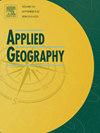Internal migration responses to housing dynamics before and after COVID-19 in Australia
IF 4
2区 地球科学
Q1 GEOGRAPHY
引用次数: 0
Abstract
Housing costs are a well-established constraint to internal migration. Rising costs typically reduce inflows while increasing outflows, particularly in large cities. Given the current housing affordability crisis in many countries, we extend evidence on the links between housing market dynamics and internal migration in three principal ways. First, we consider not only housing costs but also supply and distinguish between standalone and attached dwellings to provide more granular evidence. Second, we contribute a case study of Australia, where evidence is critically lacking despite remarkable housing price increases and wide regional price disparities. Third, we assess potential changes since COVID-19. To these ends, we estimate a Poisson pseudo-maximum likelihood regression with origin, destination, and year fixed effects on annual bilateral migration flows between capital cities and non-metropolitan regions from 2012 to 2023. We find that internal migrants respond to both origin and destination housing prices. Specifically, a 10 per cent increase in average prices at origin results in an 8.07 per cent increase in outflows, while a similar increase in destination prices reduces inflows by 3.96 per cent. Interregional flows also respond to an increase in housing supply at origin, albeit less so than an increase in housing price. The association between housing market dynamics and migration was greater at origin than destination before the pandemic. However, since COVID-19, migration flows have become more responsive to housing price at destination, particularly in the detached housing market. These results highlight the growing role of housing market dynamics in shaping internal migration flows.
澳大利亚国内移民对2019冠状病毒病前后住房动态的反应
住房成本是国内移民的一个公认的制约因素。成本上升通常会减少流入,同时增加流出,尤其是在大城市。鉴于目前许多国家的住房负担能力危机,我们从三个主要方面扩展了住房市场动态与国内移民之间联系的证据。首先,我们不仅考虑了住房成本,还考虑了独立住宅和附属住宅的供应和区分,以提供更细致的证据。其次,我们提供了一个澳大利亚的案例研究,尽管房价显著上涨,区域价格差异很大,但证据严重缺乏。第三,评估新冠肺炎疫情以来的潜在变化。为此,我们估计了2012 - 2023年首都城市与非大都市地区年度双边移民流动的泊松伪极大似然回归,其中包括起源、目的地和年份固定效应。我们发现,国内移民对原籍地和目的地的房价都有反应。具体来说,来源国平均价格上涨10%会导致资金外流增加8.07%,而目的地价格的类似上涨会使资金流入减少3.96%。区域间流动也会对来源国住房供应的增加做出反应,尽管不及房价上涨的作用。在大流行之前,住房市场动态与移民之间的关联在来源国大于目的地国。然而,自2019冠状病毒病以来,移民流动对目的地房价的反应更加敏感,特别是在独立住房市场。这些结果突出了住房市场动态在形成国内移民流动方面日益重要的作用。
本文章由计算机程序翻译,如有差异,请以英文原文为准。
求助全文
约1分钟内获得全文
求助全文
来源期刊

Applied Geography
GEOGRAPHY-
CiteScore
8.00
自引率
2.00%
发文量
134
期刊介绍:
Applied Geography is a journal devoted to the publication of research which utilizes geographic approaches (human, physical, nature-society and GIScience) to resolve human problems that have a spatial dimension. These problems may be related to the assessment, management and allocation of the world physical and/or human resources. The underlying rationale of the journal is that only through a clear understanding of the relevant societal, physical, and coupled natural-humans systems can we resolve such problems. Papers are invited on any theme involving the application of geographical theory and methodology in the resolution of human problems.
 求助内容:
求助内容: 应助结果提醒方式:
应助结果提醒方式:


